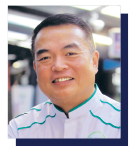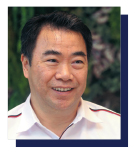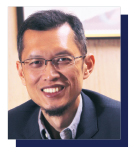Cover Story: Re-evaluating the built environment
Stay-at-home orders owing to the Covid-19 pandemic, locally known as the Movement Control Order (MCO), have made many appreciate the importance of a home. It is no longer just a roof over our heads that offers safety and comfort — it has become a remote office, a homeschool as well as a recreational and interactive space. The outbreak earlier this year led to the restriction of movement in most parts of the world, and it is anyone’s guess how much longer we will be required to spend most of our lives indoors. As a result, many are rethinking what they want from their living space.
City & Country asked the heads of companies ranked among the top 10 of The Edge Malaysia Top Property Developers Awards 2019 for their views on what the new normal would look like for our built environment and the trends and strategies they plan to adopt. IOI Properties Group Bhd, UOA Group Bhd and IGB Bhd declined to participate in the opinion poll.
Meanwhile, submissions for The Edge Malaysia Top Property Developers Awards 2020 are open. All non-listed property developers are encouraged to submit the form and supporting documents for consideration while all listed companies are automatically in the running.
S P Setia Bhd president and CEO
Datuk Khor Chap Jen

While some adjustments can be made for the “new normal”, I do not see a drastic realignment in the near future. The Covid-19 pandemic may only affect us for another 18 to 24 months or until a vaccine is found. During this pandemic, some would be “living as usual”, whereas others would find it necessary to adopt a hybrid type of home — one that can quickly be turned into a home office.
As a whole, we are moving towards a digitalised way of living, and the pandemic has inadvertently expedited this journey with the realisation that solid network infrastructure and connectivity are the fundamentals of seamless living in a digital age. Secondly, there must be conducive and flexible interior spaces such as a home office, exercise room, study area and play area to accommodate various activities. Some with additional means will also realise that instead of seeing the home as just for basic needs, it would be time to upgrade and find one with enough space for a productive home office and comfortable living quarters.
Post-pandemic, I foresee that people will value their homes more than before, and buyers will be more discerning in choosing functional designs that serve their needs. At
S P Setia, we design homes that cater for a variety of buyers from different walks of life and our designs are continually fine-tuned based on surveys, focus groups and feedback from our buyers.
As an example, our integrated developments and townships offer homes that feel private but also give a sense of community as humans still need to socialise — something that the current pandemic is helping us rediscover. Hence, amenities and common areas will always be a selling point but with added security and safety, which have become a more vital decisive factor now.
Well-integrated developments will always be sought after. This is where S P Setia’s “Live Learn Work Play” development philosophy is most relevant as more people will want to live in self-contained and self-sustained developments that not only have facilities and amenities a stone’s throw away but also enable residents to know and trust one another.
Also, this pandemic has affected people’s view of staying together. As it is our culture to care for the elderly, many would have aged parents staying with them. I foresee a rise in demand for dual-key units, which allow family members to be close by but have separate access, owing to lessons learnt from outbreaks such as Covid-19. There could also be options to stay nearby or within the same neighbourhood.
In the short term, as the outside world becomes less “touchable” and more are seeing their living spaces as a refuge, people would want their homes to have more functional qualities. As an immediate initiative, S P Setia will provide facilities to support the work (or study)-from-home arrangement and social distancing practices in common areas.
In the longer term, we will continue to improve on our designs to meet evolving market needs. We want to identify possible underserved areas in terms of our designs and functionality. We will also continue, if not hasten, our digital transformation process for our customers and buyers in their journey of purchasing, owning and living in a Setia home.
Mah Sing Group Bhd founder and group managing director
Tan Sri Leong Hoy Kum

Businesses will be required to reassess and re-evaluate their business plan for the new built environment to understand the new norm of consumer behaviour in future developments, which includes health, cleanliness and protection within personal circles. People’s sense of personal space and hygiene is being radically altered, and future designs will take into account these new social demands. It is important to conduct a thorough exercise on design thinking to understand the new customer expectations, perception and demand in future developments.
In terms of the group’s ongoing projects, we will introduce adequate directional signages within the space to minimise contact. We may not be able to modify our current plans much but we will advise customers to opt for additional rooms or dual-key units to cater for immediate needs such as a study or workspace.
To cater for the new normal, future developments are expected to have enhanced design features for the safety and welfare of the resident community. Investing in high-technology features will also be a unique selling point.
One of the new demands is a surveillance control system that will go beyond security monitoring to social crowd distancing and hygiene and protection control. In this respect, information technology intervention and sensors are inevitable; there will be individual or crowd analysis, facial recognition and environmental detections. Walking along corridors, accessing lifts and paths to common facilities — one-way traffic may be introduced to reduce the frequency of contact. There will also be increased sanitation of common facilities. Vertical movement of human traffic should also be reviewed by providing more lifts or higher-speed lifts, as well as the introduction of touchless technology, including automated faucets and sensor light controls.
Future developments will most likely take into consideration the need for house quarantine in a separate room in anticipation of a possible infection. We also foresee total isolation design concepts to be adopted for mixed-use developments in both the residential and commercial components. In addition, the design of future developments should help homebuyers adapt to the new normal, which is to avoid close contact, enclosed spaces and crowded areas. For social distancing purposes, open-plan layouts for offices are likely to become a hybrid of open space and cubicles.
Meanwhile, Mah Sing has migrated to a home-based digital work environment during the MCO via Microsoft Teams, which has fostered greater collaboration and efficiency within the organisation, as well as with our external consultants. To serve existing customers and reach future customers, we will continue to enhance our use of online platforms, including virtual show units. During the Conditional MCO period, we continue to implement additional measures, including mandating virtual meetings between our employees and consultants, separation of workforce between HQ/offices and sites, and a staggered workforce. This mindset change will allow the company to stay ahead of the curve.
Eco World Development Group Bhd president and CEO
Datuk Chang Khim Wah

It has been a good time for us to reflect on what we truly want in life and, going forward, the built environment will definitely see changes. Homes used to be a place for people to rush back to after work in their hyper-busy pre-Covid-19 lifestyle, but today, they have become our office, school, entertainment and recreational space.
So far, we have not made any immediate changes to our current project designs as we believe efforts made over the years to create great homes and living environments in all the group’s projects are well appreciated.
In terms of the shift in demand for amenities and common areas, we have asked our customers what they really want in a home after being stuck at home for about two months. The feedback included good internet connectivity; enhanced security features; a healthy, clean and green living environment; well-maintained and well-equipped communal and public spaces; ample space for me-time and family time; as well as proximity to amenities within a 10km radius from home.
Moving forward, we will continue to offer products and features that meet the ever-evolving lifestyle aspirations of consumers.
IJM Land Bhd managing director
Edward Chong

The Covid-19 pandemic has undoubtedly changed our daily lives and the way we live, work and shop, and new trends will emerge, which will be the new normal, with a greater focus on public health, safety and technology.
The pandemic has accelerated the use of digital technology, and the demand for e-commerce offerings and home delivery services will most likely flourish in the foreseeable future.
Property developers have to rethink urban space design and planning, which will pave the way for more developers to incorporate smart-home features on a bigger scale. Hence, we will consider how residents reinvent their lifestyles and support these evolutions by making their living spaces more convenient and meaningful through better space planning and smart-living solutions.
In the medium to long term, demand for flexible space will remain an important feature in new developments.
As for working from home, we expect this trend to continue for a certain period of time post-CMCO. This new normal is for the long haul, to curb the spread of pandemics, as well as a new continuity plan for many businesses in Malaysia. These new measures have changed how we live and work, including how much floor space will be needed in future.
The work-from-home culture has led many employees to create better home offices and it is a growing trend. Currently, there is a real focus on how we can reconfigure the layout of residential units to allow a dedicated and functional work-from-home space. These solutions will then be applied in the design and execution of our products in some of our ongoing and new projects.
Meanwhile, common areas and amenities will continue to be required to meet the needs of the community. We will readapt and redesign these spaces to incorporate various prevention and safety measures for those using these areas and amenities.
Customer experience expectations have become a significant priority for the company. We will closely monitor the ever-changing lifestyle needs and housing preferences of our customers as critical reference points and develop new solutions to meet their needs.
Gamuda Land CEO
Ngan Chee Meng

Gamuda Land’s development principles — a mindful planning approach, getting the places right and creating a community-centric town — have guided us to truly deliver what people need. They give us foresight to respond to the new norms we are facing.
Our home designs are carefully thought through to create functional spaces based on individual typology. With Gamuda’s digital industrialised building system (IBS), we are also able to create a beamless living space that makes a home look more spacious and airy.
For example, our Light House was designed to allow more than 70% of natural lighting and natural ventilation into the house while Flexi House was conceptualised for multi-generational living, with ample space for privacy, including space for a comfortable home office. Both the Light House and Flexi House are types of landed property introduced in twentyfive.7.
Each of our developments is mindfully crafted to include ample greenery, lakes and water features. A hallmark of Gamuda Land’s developments is our signature central park. When you are confined to your home most of the time, these things become essential to your lives. Additionally, our master plans include a town centre where shopping and eating places are located to ensure residents have access to essentials without having to travel far.
Meanwhile, working from home is not a new normal for many. Some IT professionals, freelancers and agents have been working outside of the office. Our developments, such as High Park Suites, have facilities including a common office space and a business centre, supplemented by WiFi for residents. These facilities are important for people working from home during this time.
Our residents in Gamuda Cove will get to enjoy high-speed 5G connectivity, powered by Maxis, when it is officially launched.
With Gamuda IBS, we are able to effectively manage our employees’ safety during this challenging time. Instead of foreign workers on site, Gamuda’s digital IBS allows for a built environment off-site with automation, effectively reducing reliance on foreign workers by 70%. This reduces the risk to our people’s safety as work is generally confined within our IBS plant with proper social distancing, hygiene and tracking processes.
Sunway Bhd (property division) managing director
Sarena Cheah

People will now better appreciate self-sustaining townships and developments that are equipped with comprehensive facilities and conveniences, as the new norm of less travelling means they can walk to shops and amenities while having the option of working from home.
High-speed internet capabilities and energy-saving features will become a necessity for almost everything that we will be doing. The quick adoption of digital technologies will assist us in getting used to the new norm without having to change much of the physical infrastructure.
For Sunway, layout changes will not be drastic as long as they are functional and serve their purpose of catering for the different market segments. Changes to the sizes and layouts of residential units will be limited, owing to affordability considerations. However, the need to spend more time at home has underscored the need for spaces to be more efficient and functional.
As a company, we have worked to ensure that all spaces within our new developments are functional and multi-purpose. For example, innovating the usage of spaces such as balconies or keeping storage off-site in cheaper locations will allow for a more efficient and functional layout for the kitchen or study/office areas in catering for studying/working-from-home needs.
There could be a higher appreciation for dual-key units, which can be very useful for conversion into a self-sufficient quarantine unit within a home. There will also be a desire for larger room windows for a more liveable space as people are spending more time at home.
Meanwhile, we believe there will still be social needs. Up to just before the Covid-19 outbreak, we had seen the living space shrinking further and common spaces in co-living developments increasing. Again, owing to affordability concerns, we believe such trends may continue. However, more frequent cleaning activities and designs for sufficient ventilation will be expected.
Digital tools and apps will also assist with crowd management, such as via online booking and schedules, so users can plan ahead of time to ensure space and privacy when using amenities.
We anticipate a need for customisation via design and layout options, particularly when working from home is the new norm. There will be an emphasis on facilitating technology and e-commerce deployment, that is, ensuring good internet connectivity, including fibre and 5G, moving forward.
We also expect greater adoption of smart-home systems, such as Alexa or Google Home, which reduce touch points such as switches and remote controls and help in energy efficiency; as well as facilities like delivery lockers or other contactless drop-off facilities for e-commerce deliveries; mobile applications for security and visitor screening; online facilities booking; and online property management requests. We will look into creating online communities, such as online yoga and cooking classes, as well as virtual pubs, to complement physical communities.
Sime Darby Property Bhd group managing director
Datuk Azmir Merican Azmi Merican

At this moment of being homebound, people will value their homes more than before and aim to make spaces more functional and fluid to accommodate temporary and sometimes ad hoc activities. More importantly, we need the experience to be enjoyable regardless of what function the space serves.
The new norm will have an impact on the design of single and multi-family homes going forward. It will not be a surprise if people have different expectations and aspirations regarding what a home can and should be after we emerge from this pandemic.
There could be a shift in the property-buying trend where people may consider living in newly planned sustainable, suburban township developments with landed properties that can offer space and a garden. Those living in urban areas may be attracted to live in self-sufficient stratified developments with full-fledged common facilities and located near public transport.
We have constantly reviewed our current product designs to address the current and future market needs. For landed properties, we are exploring more sustainable features such as solar photovoltaic panels to provide renewable energy to our homes with the intention of helping homeowners reduce their monthly utility bills and carbon footprint.
Similarly, for our integrated strata developments, we are addressing the provision of amenities and facilities to meet residents’ needs in terms of social interaction and purchasing and taking delivery of e-commerce goods.
Meanwhile, we can see that the trend is shifting towards permanently working from home. Companies are aware that they can conduct work virtually, and flexibility is now key. Hence, we foresee that employers are likely to downsize their leases and opt for flexible office spaces that allow for frequent redesigns rather than long-term leases.
For businesses in which working from home is not ideal, we can expect office space/design trends to shift from co-working spaces with “hot desks” and communal amenities to more sanitary private areas. This would mean most office spaces will probably have to be reconfigured in order for people to feel safe — such as having more distance between desks, wider corridors and doorways, more partitions between teams and private spaces/offices for people. The same goes for communal areas such as lobbies, pantries and meeting rooms.
One of the key growth areas that Sime Darby Property has begun to embark on since the last financial year is the industrial and logistics sector. While we can expect lower foreign investments from the widespread economic damage caused by the pandemic, e-commerce logistics has been the least affected. One feature we may have to consider incorporating into our industrial and logistics products is the integration of technology into warehousing.
We are also exploring digitalisation opportunities in order to adapt to a quickly changing operating landscape — virtual open houses and showings, augmented and virtual reality, and targeted and personalised sales. On top of that, we have also started to explore new ventures and strategic collaborations with PropTech start-ups and technology companies to discover new and complementary niche offerings, products and services. Some examples would be incorporating tech-enabled features such as no-touch mechanisms for points of entry and exit and designing buildings that are carbon-neutral and energy-efficient.
In terms of immediate priorities to navigate this crisis, we are in the midst of strategising the right balance between capital preservation and further strengthening our competitive differentiation in the market.
UEM Sunrise Bhd managing director and CEO
Anwar Syahrin Abdul Ajib

We do think that the new built environment will need to be re-evaluated. For developers like us, it is essential that we understand these future trends and design homes accordingly.
Innovation in design starts from having a clear understanding of our customers’ needs, and success will be driven by how enticing our products are to our customers. That is why for us the philosophy of EVE (Exciting, Value-driven and Easy to own) is crucial as we embark on an uncertain future.
The prolonged MCO and work-from-home environment has transformed many aspects of our daily lives. Homes of the future will be more than a place to rest, sleep and have meals with your loved ones. The experiences of the past few weeks have also shown that a home resembles a pod that connects us to many other service providers, which form part of our daily activities.
Our current designs are made to withstand changing trends and generational shifts. Though we may experience a new normal in terms of our interaction with other people and time spent at home, our developments have been surgically and meticulously planned with customers’ needs and desire for privacy, comfort and safety in mind.
For example, our developments are planned to make home life as comfortable as possible and minimise the usage of energy and water through sustainable features such as north-south orientation and an energy-saving air-conditioning system. We also take into account having flexible spaces that can be customised to suit the occupant’s needs, such as private studies and larger balconies, which would fit into the work-from-home scenario perfectly.
We have a large and diverse portfolio of products and offerings that cater for the different customer profiles and needs. We believe our customers would still want to be involved in a vibrant community, so there will not be much change in the demand for shared spaces.
However, there are some lessons that we can learn from this prolonged MCO period. There will be an increasing need for a reliable and high-speed broadband infrastructure, as well as a system to pick up or drop off items from food deliveries and purchases through e-commerce.
The low-touch, social distancing economy could also trigger higher demand for safety-related initiatives such as contactless access from entrance to lobby, car park, lifts, facilities areas and into homes.
With a digital-first focus, we continue to concentrate on local project deliveries via our marketing and branding campaigns, ensuring that communications and promotions are sensitive and relevant to the current situation. We have ramped up our digital customer experiential efforts such as virtual walkthrough of our projects and are utilising video conferences to further personalise our service to our customers.
We have also invested significantly in technology to improve our operations. Our efforts are starting to bear fruit, with a reduction in costs and go-to-market timeline.
The content is a snapshot from Publisher. Refer to the original content for accurate info. Contact us for any changes.
Related Stocks
| ECOWLD | 1.420 |
| GAMUDA | 5.180 |
| IGBB | 2.460 |
| IOIPG | 2.140 |
| MAHSING | 1.230 |
| MAXIS | 3.500 |
| SIMEPROP | 0.890 |
| SPSETIA | 1.350 |
| SUNWAY-PA | 3.000 |
| UEMS | 1.030 |
Comments